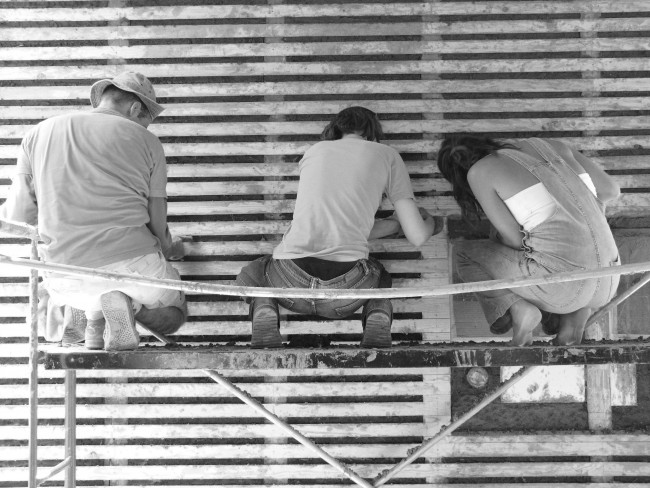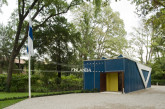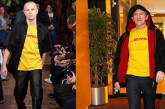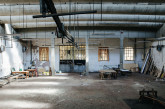PLANO B IS AN OFFICE OF YOUNG ARCHITECTS. Formed by Eduardo Carvalho, (Lisbon 1974), Francisco Freire (Lisbon 1975) and Luis Gama (Lisbon 1974), which develops architectural designs and building prototypes using both natural and industrial materials and processes.
They reflect an ethical, social, political and economic position amongst the architecture industrialized context.
The statement of plan B comes as fresh air to the architectural profession. For example when they suggest the possibility that architects should not be paid. They emphasise the stupidity of our times and the relation of the “client” with the work of architecture.
How much do architects earn? Are architects free and is their work considered? Why be paid if the client is not interested in the work? If the architect is not paid can he finally be free? Is the work of architecture held in consideration? What is the work of architecture perceived by the client? In practice, Plan B operates in a very interesting way, developing small projects that it then ask friends to help then to accomplish (i.e. really constructing it). This approach also enables Plan B to explore in a more conceptual and utopian way, different solutions, allowing it to freely take forward visions for possible architectural solutions.
The contradiction makes part the statement in a conscientious form, a critical position organized by human conciseness of it’s complexity. Nowadays every one looks for the solution and the way out that could in a magical way save at once the entire world and our schizophrenic society, Plan B propose different solutions without pretending or expecting to know the ultimate solution.
Between contradiction and complexity, rather than clearness and clarification, plan B operates in this world looking for a question and trying to find answers, which lead to further questions.

What is plan B? How would you call yourselves?
The expression ‘plan b’ refers to some alternative way to solve a problem. In movies or books a plan B is triggered when the main plan isn’t working, whenever there is a setback. In a way it’s a trick to get the audience more involved with the story and its characters. Considering our pessimistic view on life, we assume there is always a misfortune ahead, so it seems appropriate to consider, seriously, a plan b.
Our office started as ‘Plano B, alternative architecture’, because ‘alternative architecture’ was the name used in the US referring to buildings that used natural materials (such as straw bales or earth) in their construction. After some point we dropped the ‘alternative’ because we realized that the term was being used as a way of criticizing ‘modern’ architecture as a whole and a call to a presumed more ‘natural’ way of design. Being academically trained architects and wanting to act in that realm, we felt that being called Plano B architecture would be enough.
We also realized that there shouldn’t be a gap between architecture and ‘alternative architecture’. In the end we just want to produce architecture, and that seems to be a genre on its own! Our focus has been the use of natural materials and processes in conjunction with industrial ones.
I know that you would accept not be paid for what you do. What is the concept behind that idea?
The issue here is not so much “money”, or to get paid, but rather the distrust in the notion of “profit”. What’s scary about profit is the way it has got to the heart of human relations.
We like the safety and comfort money brings, as much as anybody else. We just find that so much of what we criticize in our time originates from the pursuit of profit.
We are considering accepting different ways of payment in order to divert the idea of payment from the idea of profit. That is, what is the profit you get if the payment is 1000 apples, instead of 900 apples, if you aren’t in the apple business? You may end up eating apple pie. It would be the satisfaction of a need or desire – to eat apple pie – without the interposition of money as profit.
Of course this is ambivalent, as someone who likes meat but hates the slaughter of animals. The only way to get meat would be, as in Douglas Adams’ novel The Restaurant at the End of the Universe, to produce cattle that comes to the table and says: ‘Good evening’, I am the main Dish of the Day. May I interest you in the parts of my body?’
To which one may comprehensively dispute, as Arthur Dent, the anti-hero of the story does, that it is ‘heartless to eat an animal that is inviting me to’. But also accept the counterargument that it is ‘better than eating an animal that doesn’t want to be eaten’. What to choose then?
‘A green salad’! That seemed to be the way out. When the final blow comes: ‘A green salad?’ said the animal, rolling his eyes disapprovingly at Arthur. ‘Are you going to tell me,’ said Arthur, ‘that I shouldn’t have green salad?’ ‘Well,’ said the animal, ‘I know many vegetables that are very clear on that point’.
One shouldn’t be scared of facing the problem to its limit: ‘Glass of water please,’ said Arthur.
So there you are, we are choosing ‘water’ to avoid the problem of ‘profit’. Probably facing the problem in the harshest way, without solving it: to starve.

The concept of sustainability is spread by the world, more like a fashion than a logic. What is the need to answer to this kind of questions nowadays?
To be sustainable. How to sustain ourselves, how to keep in existence? This is the question Sustainable Development has set. It is a quantity issue: how much, how many, and how long. But the difficult question is, it always was: why to keep in existence, in what way?
We are to answer the first question through the development of new, better, environmental safer technology, new types of energy and so on. It is a challenge for science (and political and economical strategy). But the second question is always coming back, on the verge of not being answered. It is the quality issue that Sustainable Development has difficulty answering.
We can imagine a time when development has given the majority of human population decent, we might say, human conditions. It seems awkward, though, to imagine that this developed population has renounced violence, exploitation, and selfishness, as those seem to be human preconditions of existence. As J. Foa Dienstag wisely suggests: ‘we must learn to hope in the absence of an expectation of progress’.
Could we achieve a sustainable condition through the inhibition of human nature instead? We would then have a Withdrawal Development. Could this inhibition be voluntary or must genetic manipulation be used for the purpose? The shadow of fascism and eugenics comes threateningly to mind.
So let’s stick to Sustainable Development for a little longer and hope that a new, better species will naturally arrive.
Your works have some different scales and deal with different layers, different materiality’s. What is the importance of the materiality in the discourse of sustainability?
I believe we are working with 3 different layers related to materiality: static, aesthetics, ethics. These are pretty much the vitruvian principles. Working with natural materials sets us the challenge of overcome their fragilities through constructive ingenuity; also to explore the particular presence and character of these materials; and finally to insert our projects with some kind of conscience for our time and for human condition.
Materials may have a symbolic or even pedagogical role in the sustainability discourse. They may have low embodied energy, be locally gathered, be recyclable or recycled, and so on. Natural materials have also proven that they can last for long periods of time. All of this may be used if architecture is to make a statement about sustainability.
But the curious thing is that sustainability is being searched through the use of “more technology”; new materials, alternative energies, and not through some comeback of old materials and technologies. That is the matrix of our civilization, right? That is, to overcome difficulties through the use of “artificial intelligence”. Natural materials are used mostly for their metaphorical power rather than for their tectonic possibilities. They may be used to give a “natural” look to some high-tech building.
We use industrial materials on the surface, and use natural materials as the structural part of the building, not necessarily visible. We try to juxtapose two facts: the “natural” and “artificial” existence of stuff, hoping to achieve some sort of ambiguous result: its indiscernibility. This doesn’t have much to do with sustainability, of course.
Pedro Campos Costa




